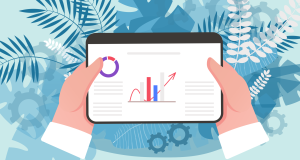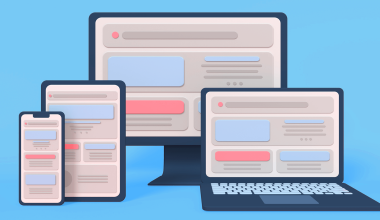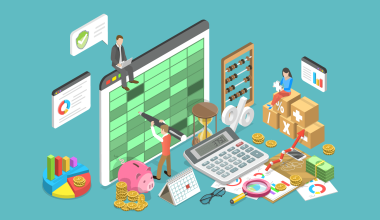For years, digital productivity has used technology to create, communicate, and collaborate like never before, with tools ranging from software apps, through to mobile devices, cloud services, artificial intelligence and more.
In the last few years alone, accelerated by the pandemic, digital productivity is no longer a niche, and plays a large part in the working life of everyday people. So, that’s the picture today – what can we expect to see in the years to come?
Contents
Contents
1. Emerging technologies
Digital productivity has already changed the way we work, and emerging tech is already making an impact – presently in real use in various ways, but not so much part of the mainstream. However, that’s just a matter of time…
5G and 6G
With its transformative potential, 5G (and undoubtedly 6G and future iterations) has the ability to boost digital productivity and revolutionize the way we connect, communicate, and experience the world around us.
Having a fast connection anywhere brings a range of benefits including faster speeds, lower latency, and higher capacity. With such speed under the hood, compatible devices can unlock new possibilities for applications like virtual reality, augmented reality, cloud gaming, and even remote surgery, offering better control and immersion. For the average person, 5G can enhance video streaming, video conferencing, and online collaboration, improving their quality and reliability for better working results. As one of the most sure future trends in digital productivity, this will have the widest adoption across the globe. As for 6G? We should be seeing it for commercial use around 2030.
Applied AI
Which the meteoric rise of systems such as DALL E 2 and ChatGPT, artificial intelligence harnesses the ability of machines to perform tasks that typically require human intelligence, such as reasoning, learning, and decision making. But it doesn’t stop there. Applied AI takes this concept and solves more specific problems in various ways, from day to day office work through to healthcare, manufacturing, finance, education, and just about anything you can think of.

Advanced connectivity
Advanced connectivity is the use of technologies that enable faster, cheaper, and more reliable data transmission across different networks and devices. These technologies can include fiber optics, satellites, Wi-Fi 6E, low Earth orbit (LEO) satellites, and mesh networks – just to name a few. With such advanced connectivity, digital productivity will benefit from better coverage and access to superfast internet, especially in rural and remote areas, and by supporting more data-intensive applications and services, such as those used by AI.
Quantum technologies
Truly on the cutting edge, quantum technologies are based on the principles of quantum physics that describe the behaviour of subatomic particles. Quantum technologies include quantum computing, quantum communication, quantum sensing, and quantum cryptography, which can offer unprecedented speed, accuracy, and security for certain types of problems or tasks that are beyond the capabilities of current technologies. It will be some time before we see its use in consumer products, but when it does, it’ll be a gamechanger. AI has been the talk of the town over the last year, but after AI, quantum computing may be the next huge global shift in technology.
2. Next-gen UX
Improved user experience boosts productivity by streamlining workflows, reducing friction, and enabling users to efficiently navigate and interact with digital tools and systems. Here are a few future trends in digital productivity from a UX perspective.
Endless integration
The way in which we interact with the technology we use can have a serious impact on productivity For instance, seamless integration between platforms and formats, intuitive interfaces, and personalized AI assistants will go a long way to making things easier. With less time spent on navigating complex systems, people can focus their energies on doing great work instead of getting frustrated by the little things.
Virtual and Augmented Reality
VR and AR have immense potential for boosting productivity by enabling remote collaboration, immersive data visualization, and efficient training. While the technology is already there at a consumer level for gaming, the productivity potential is still to be tapped. VR and AR can also be developed to offer intuitive data representation and realistic simulated environments for development of highly specialist skills, such as construction or surgery. At an everyday level, it can be used to demo products, provide training, and create more interactive remote meetings. in 2023, The global augmented reality market size was valued at USD 57.26 billion in 2023, which is already huge and will only go up as time goes by.

3. Transformative technologies
Transformative technologies are paradigm-shifting advancements with the power to reshape industries, society, and our way of life. They shake things up, disrupting the status quo and bringing in fresh ideas and possibilities that we never thought possible before.
Blockchain and Cryptocurrencies
Blockchain (otherwise known as distributed ledger) has already revolutionized transactions, which are securely recorded in a decentralized and transparent manner. In other words, there’s no middle man, enabling direct peer-to-peer trading and streamlining everything. This in turn enhances productivity by reducing costs, bypassing barriers, increasing trust and transparency, promoting financial inclusion, and driving digital innovation.
AI writing
ChatGPT reached 100 million monthly active users in January 2023, just two months after its official launch. By providing provide suggestions for grammar, spelling, style, tone, and content, they are also fantastic research tools and can essentially aggregate search results for a particular query. Naturally, this gets a lot of the groundwork done in mere seconds, but for now at least, they require a lot of human review to check for accuracy, and to give writing a more natural feel. The global AI market size was valued at $428.00 billion in 2022 & is projected to grow from $515.31 billion in 2023 to $2,025.12 billion by 2030
And no, this article was not written by AI!
Collaborative evolution
Collaborative software has gone from strength to strength in recent years, and continues to evolve at a rapid rate, facilitating real-time teamwork no matter the time or geographic location. The integration of AI automation and augmented reality will enhance productivity, while features like virtual whiteboarding, task management, and organized information systems will further streamline the way people work together.

AI Assistants
AI Assistants will be doing more than generating text or images: they are already being built into various applications to transcribe meeting notes, summarize email threads, create charts in spreadsheet applications, convert documents between different formats, and more. As the technology continues to evolve, so does the potential for productivity on scales that we could only imagine a few years ago.
Bring it on
The future of digital productivity holds great promise with emerging technologies such as 5G, applied AI, advanced connectivity, quantum technologies, and transformative technologies like blockchain and AI writing assistants. These trends, along with advancements in user experience through digital consumer experience and virtual and augmented reality, are set to revolutionize the way we work and live.
By harnessing the power of these technologies, individuals, organizations, and society as a whole can achieve higher levels of performance, innovation, and well-being in the digital age. And, with the range of OfficeSuite productivity apps always being updated where possible, we’ll be right there at the forefront.







